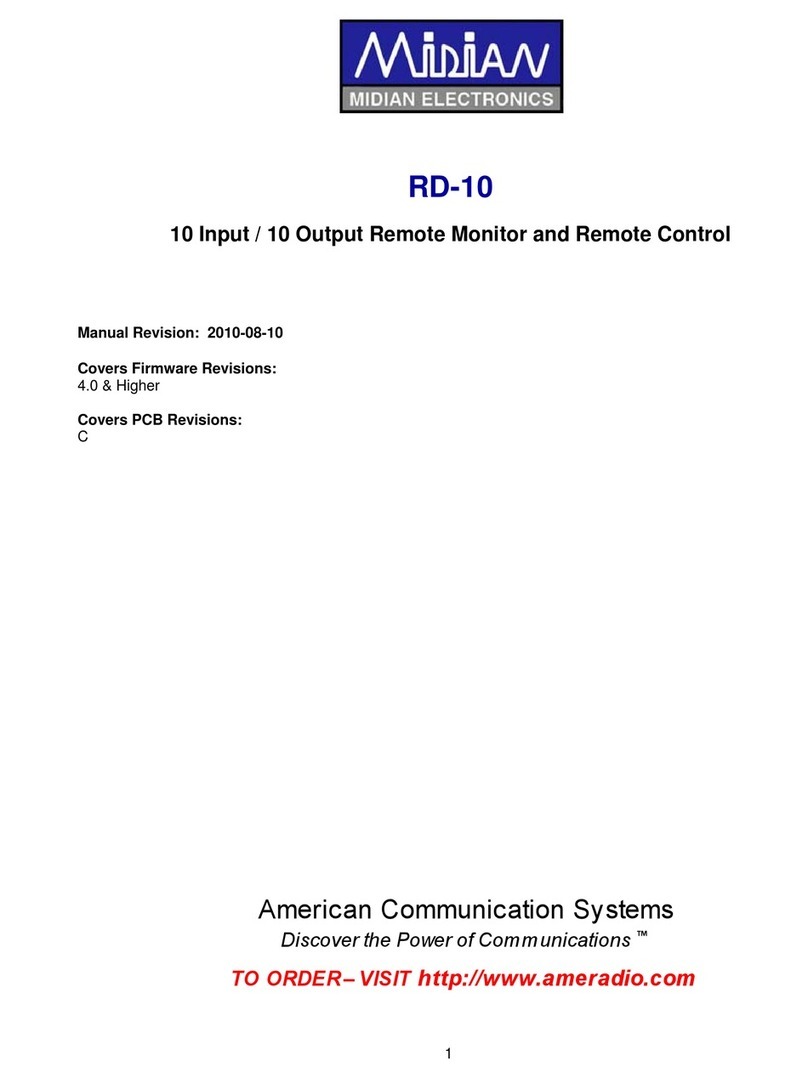
5
HARDWARE INSTALLATION
Be certain to follow standard anti-static procedures when handling any of Midian’s products.
P1-4 – Black – Ground – Connect to the nearest ground point.
P1-2 – Red - +3.7 – 15 VDC – Connect to switched B+ in the radio.
P1-6 – Orange – RX Input – Connect after the CTCSS high-pass filter in radios using CTCSS or DCS. Failure to
do so will cause the CTCSS to be inverted from a low to a high frequency. Other signaling tones that might be
used on the system should be decoded before the scrambler input. The audio path should be broken with this
lead connected to the break point closest to the discriminator.
P1-13 – Violet – RX Output – Connect to the break point described in the RX Input on the side closest to the
speaker.
P1-9 – White – TX Input – Connect to the radio modulator circuit before the insertion point for CTCSS or other
tone signaling. The audio path is broken and this lead is connected to the break point closest to the microphone.
P1-1 – Green – TX Output – Connect to the break point described in TX Input on the side closest to the
modulator.
P1-7 – Yellow – PTT Input – Selection of the RX or TX path is provided via this lead. A ground from the PTT
switch will select TX & releasing the ground will select RX.
P1-3 – Brown – Mode Input/Program Out – Connect to a momentary or latched switch for selection of scramble
or clear modes. For program out, connect this lead to the yellow clip lead from the KL-3.
P1-5 – Blue – Program In – Connect this wire to the green clip lead from the KL-3.
P1-8 – Green/White – Frequency Select A – Frequency select A, B, C and D are used to determine the selected
inversion frequency (see Table 1 above).
P1-10 – Gray/White – Frequency Select B – Frequency select A, B, C and D are used to determine the selected
inversion frequency (see Table 1 above).
P1-11 – Gray – Frequency Select C or Mode LED – Frequency select A, B, C and D are used to determine the
selected inversion frequency (see Table 1 above).
When used for Mode LED install R-34 and remove D4. Connect this wire to the cathode of the LED and connect
the anode of the LED to V+. The Mode LED output provides an active low.
P1-12 – Orange/White – Frequency Select D or Audio Enable – Frequency select A, B, C and D are used to
determine the selected inversion frequency (see Table 1 above).
When used for Audio Enable install R-36 and remove D-3. Connect this wire to a point in the radio that when
grounded turns on the audio amplifier.
Mode LED: If the frequency select lines are being used for inversion frequency selection, the Mode LED hole can
have a wire added. Connect this wire to the cathode of the LED and connect the anode of the LED to V+. The
Mode LED output provides an active low.
Audio Enable: If the frequency select lines are being used for inversion frequency selection the Audio Enable
hole can have a wire added. Connect this wire to a point in the radio that when grounded turns on the audio
amplifier.




























